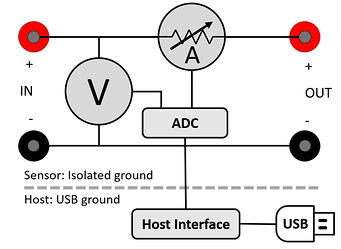In Datasheet it states that Power and Energy are calculated in Joulescope. Is my assumption correct that it is calculated just using the following formulas:
P = UI
E = P *t
Hi @jst,
I think so, but I want to be sure that I understand your abbreviated E term. So, given current I and voltage V, then power P and energy E are:
P = I * V
The Joulescope software performs Euler integration, which is the summation term shown. Note that the computation of E has lots of potential numerical issues. We use float64 over several levels of reductions (time windows) to compute the energy in each 1/2 second interval. When then accumulate using an infinite precision Python integer with units of pJ. This design choice guarantees accuracy and range to support captures that last for years.
Thank you very much for your reply. Am I assumuning correctly that the inbuilt ammeter and voltmeter measure the analog value of current and voltage respectively then it is converted in in digital values using adc converter? Also i am trying to convince our marketing department to buy more joulescopes but i need to explain the exact working of the device before I get an OK from them. The datasheet although helpful, does not go into much details behind the theory of operation. Is there a reference document, where the theory of operation is discussed in more detail?
Hi @jst,
Let’s see if I can expand. I’ll start with the figure from the “Theory of Operation” section of the Joulescope User’s Guide:
At it’s core, Joulescope is a shunt ammeter with 6 different resistor values and 7 ranges (the 0.01 Ω resistor is used for both the 10A and 2A ranges). The resistor values are listed in the “Current measurement specifications” table. The impedance varies from 0.01 Ω to 1111.1 Ω which contributes 6 orders of magnitude to Joulescope’s range. The remaining 4 orders of magnitude come from the ADC.
Joulescope performs ranging by selecting the shunt resistor using MOSFETs. Each Joulescope contains dedicated, custom analog and digital circuitry to perform the amazingly fast autoranging. The shunt ammeter works by measuring the voltage across the known shunt resistor values. That analog voltage is amplified and then converted to digital by an ADC. The Joulescope software applies a calibration to convert from raw ADC values to current, using Ohm’s law. The voltmeter scales the voltage appropriately in the analog domain, which is then converted to digital by a separate ADC. The Joulescope software applies a voltage calibration to convert from raw ADC values to input voltage. Each Joulescope is individual calibrated in the factory to eliminate device-to-device variations.
The Joulescope ammeter sensor front-end uses a chopper opamp for excellent long-term temperature and aging stability. All front-end components were selected for temperature and long-term stability.
The Joulescope instrument transfers the raw ADC values to the host computer. The host computer applies the calibration to compute current in amps and voltage in volts. It also applies the range transition filter, performs downsampling when requested, and buffers the samples for the UI and recording.
The Joulescope instrument communicates over USB, and the host uses Microsoft’s built-in WinUSB on Windows and libusb on macOS and Linux. The remainder of the Joulescope “driver” is Python code that runs in user-space. The driver provides an easy-to-use scripting environment. You can also use th driver to build integrated applications, such as the Joulescope UI, that use the Joulescope instrument data.
Does this answer your questions? What needs further elaboration?

